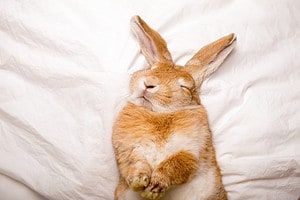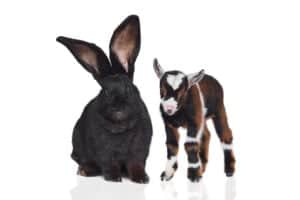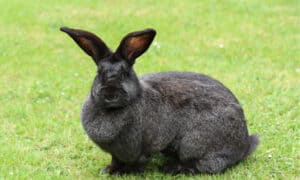Bunnies are small adorable animals that live in many climates. Their coats vary in length, thickness, and color. The thicker their coat, the warmer and more equipped they are for the cold. During the winter, these small animals go through many changes getting ready for the winter. But where do bunnies go in the winter? Do they travel far?
Keep reading to discover how bunnies survive cold, brutal, and harsh winters.
Where Do Bunnies Live?

You can find bunnies in swamps, marshes, prairies, mountains, meadows, and deserts.
©Victoria Paladiy/Shutterstock.com
Bunnies, also known as rabbits, live just about anywhere. You can find them in swamps, marshes, prairies, mountains, meadows, and deserts. It can be confusing, but bunnies are rabbits. There are no differences between the two words. They are used interchangeably. Throughout this article, we will use both, but it’s the same animal.
Wild rabbits were originally from Europe and Africa, but they thrived through trade and set up communities all over the world. There are about 29 species in total. Some bunnies are also domesticated and live indoors. With the right diet, care, and space, domestic bunnies can live up to 10 years.
Common Types of Bunnies
Bunnies are easy to mistake because they look so similar. However, there are common rabbit species with unique traits. Listed below are 4 common types of bunnies and interesting facts about each.
1. Eastern Cottontail

The Eastern cottontail can be found throughout North America.
©Rabbitti/Shutterstock.com
Eastern cottontails are very common throughout North America. You can find them in nearly all states across the south-central United States. Eastern cottontails are also native to southern Canada, northern South America, and eastern Mexico. They often live in large meadows and open fields with plenty of grass and plants. These bunnies stay in one spot for their entire lives as long as the weather permits. However, they migrate short distances if there isn’t enough food. In winter, they travel longer distances foraging for food and looking for shelter.
2. Volcano Rabbit

The volcano rabbit sometimes eats tree bark and herbs.
©Arlette Cruz/Shutterstock.com
Volcano rabbits are adorable. They are small rabbits found in mountain ranges in Mexico. Sadly, they are an endangered species. These small rabbits live up to 9 years in the wild and weigh up to 1.3 pounds. After the pygmy rabbit, they are the second smallest rabbit in the world. This cute bunny has short and rounded ears and sometimes is mistaken for a large mouse. Volcano rabbits live in groups of 2 to 5 other animals in underground nests. It’s estimated that there are less than 7,000 volcano rabbits left in the world.
3. Swamp Rabbit

Swamp rabbits can swim.
©Lawrence Jefferson/Shutterstock.com
The swamp rabbit is the largest of the cottontail rabbit species. This bunny mainly lives in the southern United States. As their name suggests, they live in wetlands and swamps. Swamp rabbits can swim. They are very common in Alabama, Mississippi, and Louisiana. Sadly, when it snows in these states, they lose snow cover and their main food sources, causing a decrease in the population. While swamp rabbits are the largest of the cottontail species, they have small ears and a cinnamon-brown coloring around their eyes.
4. Flemish Giant Rabbit

Flemish giant bunnies can grow large in size.
©Veroja/Shutterstock.com
Have you ever seen a Flemish giant rabbit in person? They are the largest domestic rabbit species in the world. These bunnies are known to grow up to 22 pounds. They were first bred in Flanders as early as the 16th century. They are the descendants of many old rabbit species, some of which are extinct. Flemish Giants require special crates or cages and lots of space. For example, in the U.S., rabbits over 12 pounds need at least 5 square feet of floor space. Flemish giant bunny owners need to feed their pets a lot of food, but the diet is similar to what other domestic bunnies need – fresh vegetables and fruits.
How Do Bunnies Survive Winter?
Some bunny species are native to cold regions of the world, so how do they survive bitter winters with freezing temperatures and snow? Bunnies survive winter by developing thicker and warmer fur. During late Fall, they stop shedding which helps thicken their coat. Unlike other animals, they don’t hibernate during winter. Instead, they forage for food and seek shelter away from predators. Since most wild bunny species have brown coats, they are easy prey for larger predators during snowfall.
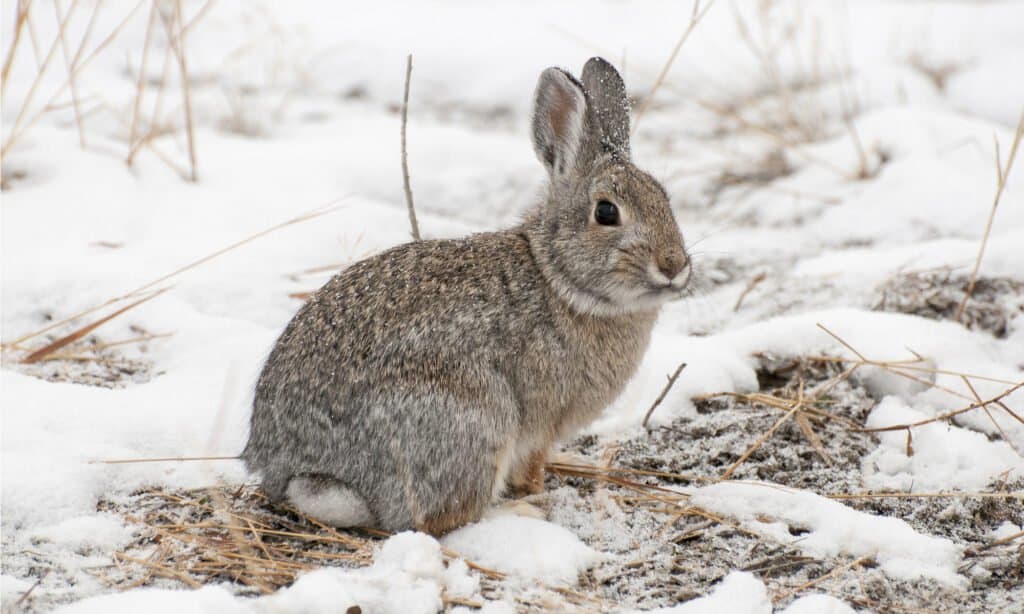
Mountain cottontail rabbit on snow with dead grass
©moosehenderson/Shutterstock.com
What Do Bunnies Eat in the Winter?
Wild rabbits eat a lot of fiber. During summer and spring, they consume fresh grass, herbs, and other light plants. However, as snow falls and the temperature drops, their food sources decline. Instead of eating grass and other greens, they look for bark, pine needles, and other wood-based food sources. They also eat cecotropes, which is the food they partially digest before consuming again. If you want to help bunnies during winter, don’t feed them directly. This will get them used to humans, and they won’t forage for food. Instead, keep a few plants outside that can thrive in winter like dandelions or other cold greens.
The Difference Between Wild and Domestic Rabbits
Domestic and wild rabbits may appear to be the same but they have very different characteristics as well as colorings. Once you know how to identify their physical contrasts, it will be easier to tell them apart.
A wild rabbit is generally a Cottontail, of which none are domesticated. They are far too easily stressed and are extremely skittish and do not make good pets. A domesticated rabbit is a breed that originated in Europe and can be playful, and full of personality.
Wild rabbits are social animals and while they do like alone time, they enjoy interacting with other rabbits as well. They generally spend their time running, jumping, hiding and eating. A domestic rabbit does have similar habits to a wild rabbit in that they love to jump and run, but a pet rabbit loves to show affection. They will climb on you, sit near you, lick your hands, and also love to play with toys.
| Wild Cottontail Rabbit | Domestic Rabbit | |
| Color | Are generally a mix of brown and black to camouflage themselves from prey | Come in different colors & patterns, like white, black, tan, and gray, and different lengths |
| Lifespan | 1 to 9 years | 7 to 10 years |
| Features | Sharp, slim faces | Soft, round faces |
| Personality | Extremely skittish, stay away from humans | May approach humans |
| Ears | Never floppy, always stand straight up. | Can be floppy or upright |
| Weight | Between 1.5 to 3 pounds | 6 pounds, depending on the breed |
| Weather | Hardy in cold temperature | Not prepared for high heat or cold temperature |
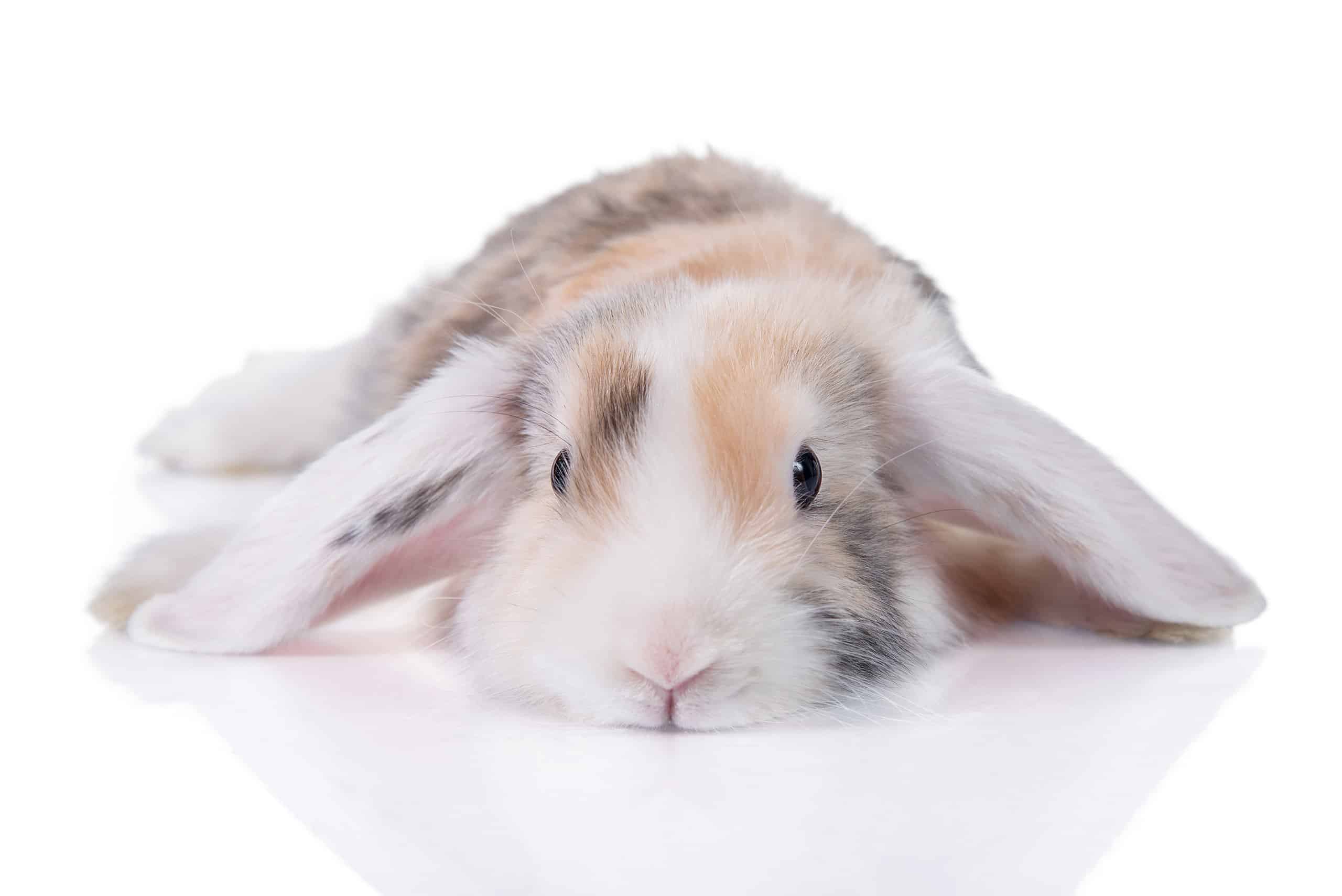
Their cute and cuddly appearance makes the Mini Lop a popular household pet.
©Rita_Kochmarjova/Shutterstock.com
The photo featured at the top of this post is © LNbjors/Shutterstock.com
Thank you for reading! Have some feedback for us? Contact the AZ Animals editorial team.




